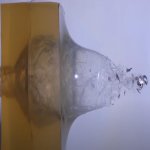lol, you make this too easy, relax, if you hate on a 6.5 because people poke the bear while speaking the truth then that's all on you and you might miss shooting a real gem because you were easily turned against it
pretty much agree with everything else you said except where emphasis to reduce variable comes before your list, and that's about placement trumps displacement, so you have to be able to shoot it really well and most shoot well under 15 ft/lbs recoil energy, if your limits are higher that's great, I've certainly made higher work as well, but do better more consistently with less, and having kids was no brainer to hit the lighter end of spectrum, but I'll stay there even when kids all grown up and gone, no reason to shoot more
and you talk who cares under 400 and I agree, then you bring long range into it, well ok, lets go there too then, we're like a pair of yo-yo's lol, all over the place

1/2 second tof is limits for most shooters on game, give or take 450-500 yards, same in archery it relates to about 50 yards, 3/4 second tof's there are a moderate amount of people consistent within, give or take 600 yards for most decent set ups, and 70 yards for the archery guys, beyond that a minuscule percentage of population can consistently kill at, beyond these distance/tof limits it comes down to everything but the cartridge/combo/rifle/scope combo, you're fighting natural field position accuracy potentials for most mortals, ~2 moa, you're fighting wind hold limits up to about 20", you're fighting a totally different kind of pressure than what is at the range, ie; you can try and get a 1/4 minute rifle but you will not kill any better any further with it over a 1.5 moa rifle, so you wasted a lot of time past the point of diminishing returns chasing accuracy that doesn't matter in the field, most simply cannot show any advantage in hit probability due to that, wind will limit most to inside a 20" max window for both ability to read it close enough and still have acceptable margin of error to land in the pie plate on an animal for real, so still a lot of your parameters you listed as very important aren't really that important, something you can shoot really well is far more important, efficiency of bullet allows you to really improve this aspect while extending distance performances on game, that's what 6.5 does over ANY 30 cal
and I do pick what I like and shoot stuff, a little wee 6.5 Grendel, kids lobbed them in there to 355 so far like rockstars, 420 for me, 6.5 ft/lbs recoil energy in a 8.25 lb rig, watch it all in the scope, 2386 fps launch...elevation isn't a concern, tof under .5 seconds so not a concern, high bc, barely nudge reticle into the wind for most shots but still in kill zone, not a concern, but recoil/muzzle blast/noise...much bigger risk for shoot ability, I can shoot a lot more just as well, but see no point now, the extra hp won't help me if I shoot poorly and more likely to make me shoot poorly, so much more goes into this than velocity, as covered before, 2500 fps is very fast
if I wanted a 1000 yard rig today it would be off the shelf of course, it would be a tikka or ruger in 6mm creedmoor and run factory 108 eld-m's, it would end up in an mdt chassis, it would pinwheel things with highest hit probability over all other choices, a little shy on bullet weight for my preference but know the sd is there and construction ideal for maximizing performance at the longer distances, also a little tougher on barrels but as a hunter that's ok, I'd get a lifetime out of it and shoot other things for volume, if I wanted a 600 yard rig today it would be 6.5 Creedmoor, it checks off every single box better than anything else off the shelf period, as it is I no longer care about having 600 yard rigs, I'm down to 400 yard rig...so I went down to that lol, progress and 21st century formula made it possible for me to do that with only 30 grains of powder per touch of the trigger, 15 head, 5 seasons, family success batting 1000, there's no replacement for placement
 6.5cm is the hands down winner for a 600 yard combined big game playtime rig over a 308, on recoil alone it wins but it runs circles around it ballistically as well.
6.5cm is the hands down winner for a 600 yard combined big game playtime rig over a 308, on recoil alone it wins but it runs circles around it ballistically as well.









































































